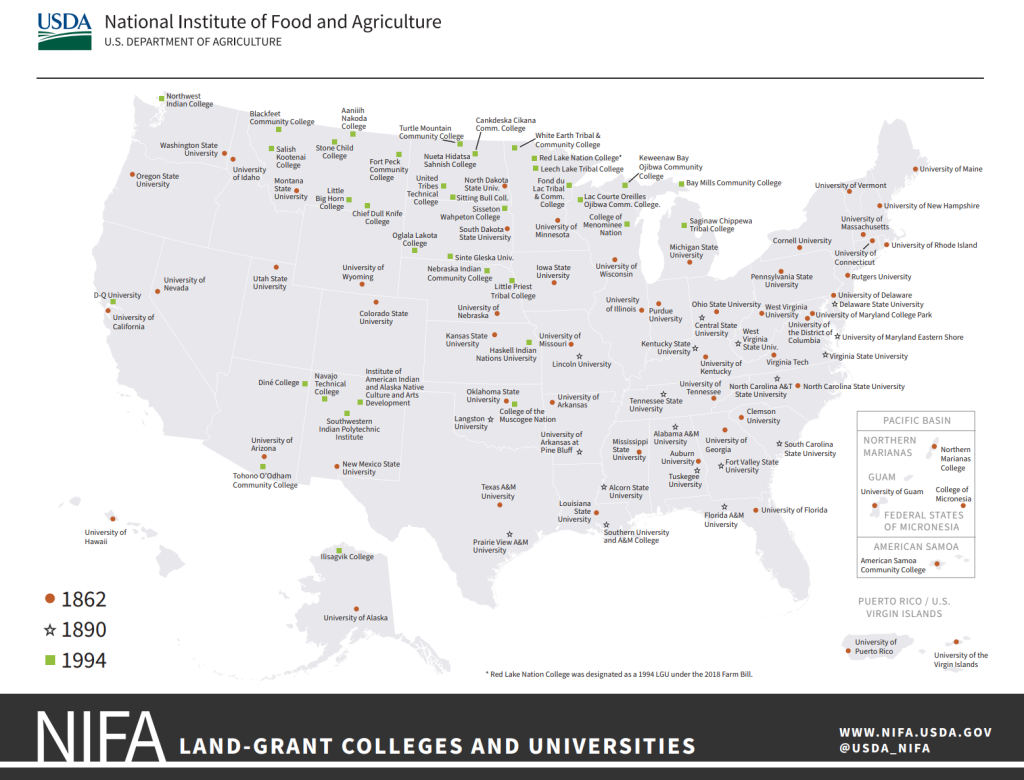By Kirstin Nelson (Follow us on LinkedIn)
When I started my job at the National Agricultural Library, I had yet to think much about land grant universities. I attended one (University of Nebraska) and remember walking past Morrill Hall almost daily. A plaque outside the building mentioned the words “land grant”, but I didn’t understand their long, difficult history. Now that I work as an agricultural law librarian, I have a much deeper awareness of land grants and how and why they were established – and how the desire to create a populace educated in agricultural and mechanical arts is one (of the numerous) reasons for the Indigenous land loss.

There are three different Morrill Acts that created different categories of schools. The 1862 Act granted land grant status to some existing colleges and helped fund the creation of new predominantly white colleges. The 1890s Act created segregated colleges in the South, and the 1994 Act provided funds to tribal colleges. Today, I’m writing about 1862 schools.
There are three different Acts related to land grant institutions. The first was the 1862 Act, which granted land grant status to some existing colleges and created new predominantly white colleges. The 1890s Act created segregated “separate but equal” colleges in states where Black citizens were not allowed at the previously established land grant institutions (mainly in the South), and the 1994 Act provided funding and the land grant designation to all tribal colleges. Today I’m writing about 1862 schools.
So, let’s go back to 1862 when Congress passed the first Morrill Act. Before that time, college was generally reserved for the elite and focused on classic disciplines. However, as the country grew to the West, there was an increased demand for people educated in agricultural and mechanical fields. Congress created a plan to “grant land” to grow existing colleges, similar to the first land grant university , Michigan State, and to establish new institutions to provide secondary education to the population (mainly white and male) to improve agricultural business and wealth for the country.
So, how was the land obtained? The government had some expropriated land through questionable treaties and tribal land seizures before 1862, but not nearly enough to implement the broad scope of the 1862 Morrill Act. The government continued those measures – treaties, seizures, and displacement – to expropriate additional large blocks of land from Native tribes. While some land was “purchased”, it was typically far below market value and involved various levels of dishonesty and coercion. It also awarded vouchers (scrip) to institutions to claim land throughout the expanding country to grow their endowments.

In 2020, the High Country News, The Pulitzer Center, and the Fund for Investigative Journalism published a report and custom geodatabase of tribal land taken or sold for a fraction of its worth for land grant universities. The investigation produced an interactive website, Land-Grab Universities, that mapped out “approximately 10.7 million acres taken from nearly 250 tribes, bands and communities through over 160 violence-backed land cessions, a legal term for the giving up of territory.” [1] The Morrill Act required the original funds for the endowments to be held in perpetuity, meaning some land grant institutions still benefit from land seized, sold, or taken via voucher. Some universities are trying to address this history and are considering ways to repair harm. One example is Cornell University, which is working with Indigenous groups to determine the best steps forward.
Let’s take time to learn more deeply about the country’s land grant institutions, especially those where we live and work, as well as those we attend or support. As librarians, we have the skills to elevate these stories and ask institutions to reckon with this problematic history from which many of us still benefit.
My next post will focus on the 1890 Morrill Act. Stay tuned!
Notes:
[1] https://www.hcn.org/issues/52.4/indigenous-affairs-education-land-grab-universities
————————————————————————————–—-————————–—-
Notes Between Us (NBU) is a blog about conversations and topics of interest to the writers. The writers are expressing their personal opinions solely. The essays represent their personal beliefs and not those of their workplaces or any organization they are associated with.
